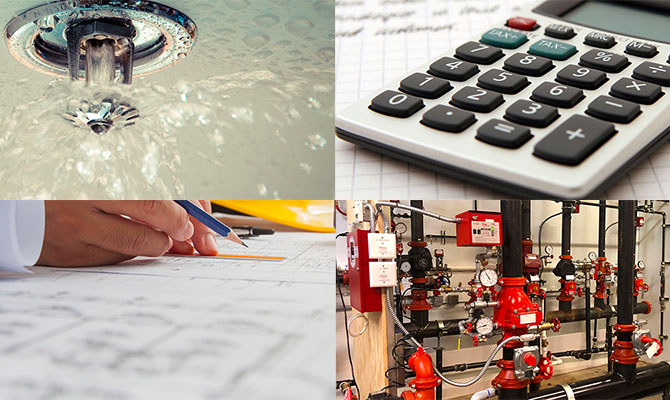Certificates will comply with CAL FIRE CEU requirements for CAL FIRE approved training courses per Title 19. Fire Smarts is a CAL FIRE approved provider for this training course which may be used towards California certified sprinkler fitter continuing education requirements that include completing 30 hours every three years to maintain the state certification (Section 946). CAL FIRE CEU’s are assigned based on 0.1 CEU per training contact hour. Learn more about CAL FIRE licenses and registration at https://osfm.fire.ca.gov/govmotus-fire
Course Description: This 10-hour course is based on the California adopted edition of NFPA 13 ‘Standard for the Installation of Sprinkler Systems’ and covers how the standard is organized, acceptable fire sprinkler system types and their applications, as well as fire sprinkler system design approaches and calculations for determining the number of sprinklers required.
Course Modules:
Module 1 – Introduction to NFPA 13 Fire Sprinkler Systems – 1hr
This module provides an understanding of the four major system types, the basic components, design objectives, and basic installation principles of fire sprinkler systems. Acceptance testing requirements are reviewed that ensure that the finished sprinkler system functions as intended.
Module 2 – NFPA 13 – Understanding the Standard – 1.5hrs
The NFPA 13 Standard for the Installation of Sprinkler Systems has over 100 years of development to become the recognized standard for all commercial and residential fire sprinkler system design and installation. This module begins with reviewing the Automatic Sprinkler Correlating Committee’s role in producing this standard and how the information is organized. Finally, specific topics such as determining the protection criteria for storage is examined in detail.
Module 3 – Fire Sprinkler System Types – Part 1 – 1.5hrs
This module reviews the design and layout of wet and dry pipe fire sprinkler systems. The requirements found in NFPA 13 ‘Standard for the Installation of Sprinkler Systems’ are covered including system uses and applications as well as general system topics such as area limitations, system size, valving, auxiliary systems, and venting. Specific requirements for dry pipe systems are reviewed including use of sprinklers, water delivery, quick opening devices, and the air/gas supply. Discussion items will also include the protection of valves, system drainage, and system configuration as well as other unique requirements for wet and dry systems.
Module 4 – Fire Sprinkler System Types Continued – Part 2 – 1.5hrs
This module will continue covering fire sprinkler system types focusing on the design and selection criteria for more specialized system types. This includes preaction systems, deluge systems, combined dry pipe and preaction systems, multicycle systems, antifreeze systems, and exposure protection systems. The requirements found in NFPA 13 ‘Standard for the Installation of Sprinkler Systems’ are covered including system uses and applications as well as general system topics such as system size, valving, auxiliary systems, and venting. Specific requirements and appropriate application for the system types are reviewed including conditions that warrant their use and the limitations of each system type.
Module 5 – Fire Sprinkler Design Approaches – Part 1 – 1.5hrs
This module will lay the foundation of the design approaches permitted by ‘NFPA 13 Standard for the Installation of Sprinkler Systems’. Participants will learn the primary design approaches and when they apply. Optimizing fire sprinkler areas of coverage and minimization of water and/or pressure demand using area/density curves will be explained. This presentation will go through several examples including sloped ceilings, use of quick response sprinklers and adjustments for dry systems and double interlock preaction systems. Emphasis on the allowable modifications and their potential advantages and disadvantages will also be discussed.
Module 6 – Fire Sprinkler Design Approaches Continued – Part 2 – 1.5hrs
This module will continue covering the fire sprinkler design approaches permitted by ‘NFPA 13 Standard for the Installation of Sprinkler Systems’. Participants will review calculating minimum water supply requirements for all design approaches. This presentation reviews the calculation methods for room design and special design areas including building service chutes and stair towers. The requirements for residential sprinklers, adjacent hazards, and mixed occupancies are also examined. The module concludes with a review of design approaches for exposure protection and water curtains.
Module 7 – Fire Sprinkler Design Area Calculations – 1.5hrs
This module expands on the Fire Sprinkler Design Approaches modules. This presentation focuses on the application of the selected design area and permitted calculation approaches to determine number of sprinklers based on ‘NFPA 13 Standard for the Installation of Sprinkler Systems’. Specific emphasis will be given to determining the size, shape, and number of sprinklers to include in the specific design area. The presentation also considers the location of the design area within the overall system and how to determine the most hydraulically demanding remote location.
Click Here to Register Online
Format: Instant Access Recorded Webinars
CEUs: Based on 10 contact hours of training (see CEUs tab for details)


